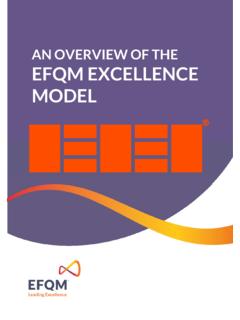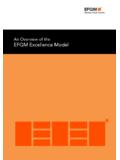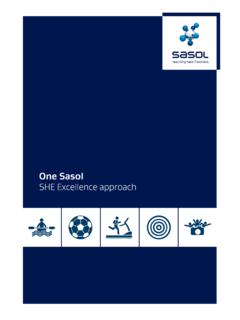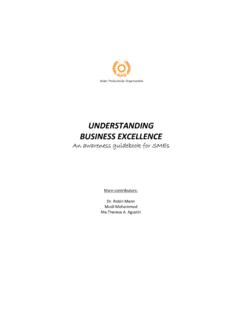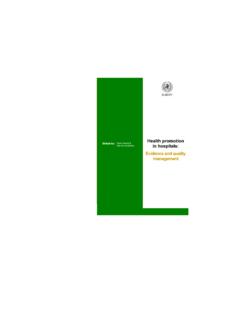Transcription of Introducing the EFQM Excellence Model 2013 - …
1 efqm 2012 Introducing the efqm Excellence Model 2013 Matt Fisher10thOctober 2012 efqm 2012 efqm Core Team Representing the efqm Assessor Community: Andr van der Geest (PostNL) Christian Forstner (CF YourAdvantage) Representing efqm Partners: Juan de Dios Calatrava (Club Excelencia en Gesti n) Representing efqm Private Sector Members: Mia Goetvinck (Ricoh) Representing efqm Public Sector Members: Anna Beker (Dzierzoniow Town Hall) Paul Evans (Liverpool John Moores University) Representing the efqm Trainer Community: Chris Hakes (LeadershipAgenda Network) Geoff Carter (PACEP erformance) efqm 2012 What s driving change?SpeedRisk ManagementDriving StrategySustainabilityFlexibilityAgility Organisational DesignLearning OrganisationGlobal MarketplaceTalent ManagementValue ChainSocial MediaCorporate GovernanceSociety as a StakeholderCore ProcessesSustainability of Business ModelEthics and StandardsIncreasing Value AddedEffective Change ManagementGenerating New ValueScarcity of ResourcesScenario PlanningOrganisational DevelopmentWork / Life Balance efqm 2012 Fundamental ConceptsRepresenting Private Sector Members: Mia GoetvinckRepresenting Public Sector Members: Paul Evans efqm 2012 What s changed & why?
2 Changes to Titles The Core Team identified some titles which were confusing or not well understood Achieving Balanced Results . We have proposed changes to make these clearer and more action oriented Creating a Sustainable Future , rather than Taking Responsibility for a Sustainable Future . Partners & Processes These concepts have been expanded to cover wider aspects of developing organisational capabilities and ensuring agility & flexibility. Partners & Processes are still important; they remain in the titles of the 9 Criteria. efqm 2012 efqm Fundamental Concepts efqm 2012 Example: Developing Organisational Capabilities Excellent organisations enhance their capabilities by effectively managing change within and beyond the organisational boundaries. In practice, we find that excellent organisations: Analyse operation performance trends to understand their current and potential capabilities and capacities and identify where development is needed to achieve the strategic goals.
3 Develop an effective and efficient value chain to ensure they can consistently deliver on their promised value proposition. Develop a culture that continually seeks to improve the effectiveness of collaboration and teamwork throughout their value chain. Ensure that financial, physical and technological resources are available to support organisational development. Establish shared values, accountability, ethics and a culture of trust and openness throughout the value chain. Work together with partners to achieve mutual benefit and enhanced value for their respective stakeholders, supporting one another with expertise, resources and knowledge. Establish appropriate networks to enable them to identify potential partnership opportunities to enhance their capabilities and ability to generate additional stakeholder value. efqm 2012 Example: Managing with Agility Excellent organisations are widely recognised for their ability to identify and respond effectively and efficiently to opportunities and threats.
4 In practice, we find that excellent organisations: Use mechanisms to identify changes in their external environment and translate these into potential future scenarios for the organisation. Translate their strategies into aligned processes, projects and organisational structures, ensuring changes can be implemented with appropriate speed throughout the value chain. Develop a meaningful mix of process performance indicators and related outcome measures, enabling the review of the efficiency and effectiveness of the key processes and their contributions towards the strategic goals. Use data on the current performance and capabilities of their processes, as well as appropriate benchmarks, to drive creativity, innovation and improvement. Effectively manage change through structured project management and focused process improvement. Rapidly adapt their organisational structure to support the achievement of the strategic goals.
5 Evaluate and develop the technology portfolio to improve the agility of processes, projects and the organisation. efqm 2012 The BMW ExperienceAndreas Wendt efqm 2012 CriteriaRepresenting the Assessor Community:Christian Forstner efqm 2012 What s changed & why? Criterion 9: Title Change The title Key Results was causing confusion as the word key was also being used to identify the most important results in all results criteria Key Customer Results, Key People Results, Key Society Results and Key Key Results. The change to Business Results is accompanied by the definition of the Business Stakeholders owners, shareholders, investors, Head Office, Government. No other changes to Criterion Titles or Criterion Part Titles Changes are restricted to the guidance points, aligned to the new concepts and using simplified language. efqm 2012 efqm Criteria LeadershipPeopleBusiness ResultsProcesses, Products & ServicesStrategyPartnerships & ResourcesPeople ResultsCustomer Results Society ResultsEnablersResultsLearning, Creativity and Innovation efqm 2012 efqm 2012 Example: Business Results Excellent organisations achieve and sustain outstanding results that meet or exceed the needs and expectations of their business stakeholders.
6 In practice, we find that excellent organisations: Develop a set of key financial and non financial results to determine the successful deployment of their strategy, based on the needs and expectations of their business stakeholders. Set clear targets for key business results based on the needs and expectations of their business stakeholders, in line with their chosen strategy. Segment results to understand the performance of specific areas of the organisation and the experience, needs and expectations of business stakeholders. Demonstrate positive or sustained good business results over at least 3 years. Clearly understand the underlying reasons and drivers of observed trends and the impact these results will have on other performance indicators and related outcomes. Have confidence in their future performance and results based on their understanding of the cause and effect relationships established. Understand how their key business results compare to similar organisations and use this data, where relevant, for target setting.
7 efqm 2012 Links between Concepts & CriteriaCriterion 1. Leadership 2. Strategy 3. People 4. Partners & Resources 5. Processes, Products & Services Criterion Part a b c d e a b c d a b c d e a b c d e a b c d e Adding Value for Customers Creating a Sustainable Future Developing Organisational Capability Harnessing Creativity & Innovation Leading with Vision, Inspiration & Integrity Managing with Agility Succeeding through the Talent of People Sustaining Outstanding Results efqm 2012 The Grundfos ExperienceLars Aagaard efqm 2012 RADARR epresenting efqm Trainers:Chris Hakes & Geoff Carter efqm 2012 RADAR efqm 2012 What s changed & why? Complex & confusing The additional bullets that were added into the RADAR in 2010 added numerous benefits but added complexity.
8 In addition, the wording of the Enabler Scorecard used the term evidence , which many found confusing, leading to different interpretations. What s Changed? The bullet points have been reduced to a single guidance point for each attribute of the RADAR. The scoring scale has been simplified to be consistent in each attribute. The wording reflects the fact that scoring is only done after all the available evidence and examples have been collected. It also changes the emphasis; it is now up to the applicant to prove they are a Global Role Model to achieve the maximum score, instead of the assessors having to prove they are not. Additional guidance will be produced, both for assessors and managers, to ensure consistent application of the RADAR. efqm 2012 What s changed & why? Complex & confusing The additional bullets that were added into the RADAR in 2010 added numerous benefits but added complexity. In addition, the wording of the Enabler Scorecard used the term evidence , which many found confusing, leading to different interpretations.
9 What s Changed? The bullet points have been reduced to a single guidance point for each attribute of the RADAR. The scoring scale has been simplified to be consistent in each attribute. The wording reflects the fact that scoring is only done after all the available evidence and examples have been collected. It also changes the emphasis; it is now up to the applicant to prove they are a Global Role Model to achieve the maximum score, instead of the assessors having to prove they are not. Additional guidance will be produced, both for assessors and managers, to ensure consistent application of the RADAR. efqm 2012 What is a Global Role Model ? To score into the final box on the RADAR, the organisation needs to demonstrate, using independent evidence, that they are considered as a Global Role Model . This could include: External recognition from a reputable 3rdparty. Being invited to speak at international conferences / educational institutions.
10 Comparisons with market leaders or organisations externally recognised as world class . efqm 2012 Example: RADAR for Results Relevance & UsabilityGuidanceUnable to demonstrateLimited abilityto demonstrateAble to demonstrateFully able to demonstrateRecognised asGlobal Role ModelScope & RelevanceA coherent set of results, including key results, are identified that demonstrate the performance of the organisation in terms of it s strategy, objectives and the needs and expectations of the relevant are timely, reliable & Results are appropriately segmented to provide meaningful GuidanceUnable to demonstrateLimited abilityto demonstrateAble to demonstrateFully able to demonstrateRecognised asGlobal Role ModelTrendsPositive trends or sustained good performance over at least 3 targets are set and consistently achieved for the key results, in line with the strategic external comparisons are made and are favourable for the key results.
